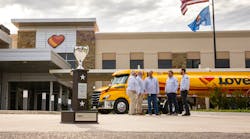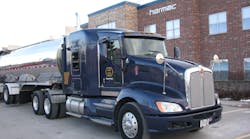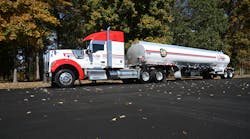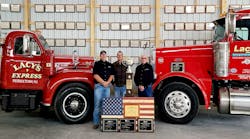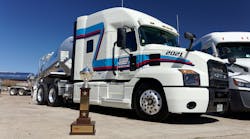THE challenge continues.
A variety of initiatives have been launched against cargo tank rollovers in recent years, but rollovers remain a pervasive and perplexing problem.
“We’re giving an awful lot of attention to this, yet they continue to happen,” said John Conley, past president of the National Tank Truck Carriers (NTTC). “Have we made progress? I think we have. There are still way too many. I think there would be even more if we hadn’t made the effort we have to this point, but clearly we need to keep it up.”
His theories on why they remain in the spotlight:
• The industry has been very busy. “We’ve been fortunate there are a lot of tank trucks out there,” Conley said.
• Cell phones and texting. “There’s no question that this is contributing.”
• The tremendous increase in shale oil and gas operations.
Conley was a panelist on “Cargo Tank Rollover Prevention FMCSA Update,” a webinar presented by Bulk Transporter in August. Here’s what the other panelists offered:
Paul Bomgardner
Chief, Hazardous Materials Division
Federal Motor Carrier Safety Administration
He listed FMCSA’s strategic plan initiatives:
• Raise the bar for motor carriers to enter the industry. “Make it a little tougher for motor carriers to get into the business.”
• Maintain a high standard of safety and compliance to remain in the industry. “Keep oversight on them and make them do the right thing.”
• Remove unsafe drivers and carriers from the roadways. “That’s the ongoing mission. That’s not only what FMCSA does every day, but we also call on our state partners and safety assistance program.”
Battle against rollovers page 2...
The hazmat strategic plan support initiatives:
• Hazardous materials safety permits: Change in crash and out-of-service rates.
• Compliance, Safety, Accountability (CSA) program: Hazmat compliance BASIC.
• Data quality. “We’ve made a lot of headway on that, and the Commercial Vehicle Safety Alliance is really taking a look at data quality.”
• MAP-21. “They just finished a review and are preparing a report to Congress.”
• Cargo tank rollover prevention. “What keeps me up at night is cargo tank rollovers. These are a problem. They continue to be a problem. It’s elusive in nature to figure out and pinpoint who is having these. We took a look at the raw data over a year-long period. There was no clear frontrunner among causes. It was spread out: interstate and intrastate highways; large and small companies; drivers who have been around a long time, as well as new drivers. It’s happening in the bobtail tank truck sector, as well as tractor-trailer units.”
FMCSA’s rollover prevention includes recommendations to:
• To the Pipeline and Hazardous Materials Administra-tion: Analyze available accident data to identify cargo tank designs that are susceptible to failure for developing accident-performance standards for newly manufactured cargo tanks.
• To the National Highway Traffic Safety Administration (NHTSA): Develop stability-control system performance standards for all commercial motor vehicles and buses that have a gross vehicle weight rating greater than 10,000 pounds as well as establish comprehensive minimum performance standards for all newly manufactured cargo tank motor vehicles.
• To the Federal Highway Administration and the American Association of State Highway and Transportation Officials: Develop guidelines for identifying and protecting bridges that are vulnerable to collapse if struck by errant heavy commercial vehicles.
He said FMCSA is in the process of developing on its website a Cargo Tank Rollover Prevention Toolbox. It was developed under logo of “Keep the Load on the Road” and will have links to:
• ATRI rollover hotspot map. “It’s a very good tool in identifying where rollovers happen most frequently.”
• Cargo tank rollover prevention video. “It was developed in 2009 but is still very relevant. Recently, NTTC took the information and made a version for emergency responders because unfortunately we are seeing some rollovers in water tankers operated by fire departments. It’s not just a hazmat issue.”
Battle against rollovers page 3...
Doug Pape
Project manager
Battelle
He said 60% of cargo tank rollovers involve tractor trailers and 40% involve straight trucks. Driver error figures in 75% of rollovers, and 16% were induced by another vehicle.
“We’re all in this together,” Pape said. “Everybody in the industry is involved in preventing rollovers. How do all of us help the driver to make good decisions? How do we help the driver see the situation 100% of the time?”
In dispelling myths about rollovers, he said they don’t all occur at interchanges, and speed is a factor about half the time.
In the Battelle Report for the Transportation Research Board, Battelle examined what a good safety program looks like.
Areas where management can help:
• Training. “Rollover prevention training is important for both novices and experienced drivers.”
• Fitness for duty. “The hours-of-service rules are the bare minimum. Good sleep practices matter. Overall health is important, too.”
• Operations. “Avoiding risk—like staying away from bad roads—is as important as direct prevention.”
• Meetings. “Make sure your next safety meeting is about safety, and not changes to your 401(k) program.”
Pape gave some reminders about sleep: everybody needs six to eight hours of continuous sleep every day, some more; drivers and dispatchers have the responsibility for allowing that sleep to happen; compliance in hours of service is only the start; general health matters too. He said the North American Fatigue Management Program was developed by FMCSA and Transport Canada and tested with carriers and drivers, who got more sleep on work days, decreasing absenteeism.
Pape said behavior-based safety is a team effort and requires a “want-to”attitude instead of “have-to.”
Battle against rollovers page 4...
“Get to the root cause,” he said. “Nobody likes to talk about mishaps, but you have to take time to learn from them. How often do you see an incident report like this? Pump broke. Pump fixed. That’s not very useful. What have we learned from rollovers? We’re starting to approach insurance companies and see if they can dig back into their files for a rollover that was settled, and then de-identify it and turn it into lessons learned.
“The useful incident report would read like this: Pump broke. Because the seal went bad. Because it was the wrong material. Because the supplier sent the wrong part and nobody here noticed. So we will check the packing slips.”
His tips on the safety culture:
• Take training seriously. “Some instructions are counterintuitive, like ‘swerve to avoid.’ ”
• Communicate. “Stay on top of road-construction plans and warn rookies of difficult merges.”
• Follow procedures. “Safety first, period. Efficiency is impossible without safety. When there’s a split load, company guidelines on how to load it and where to drop it have to be followed.”
• Everybody’s involved. “The CEO walks the walk. The janitor doesn’t leave trip hazards around the office.”
Steve Niswander
VP, safety policy and regulatory relations
Groendyke Transport Inc
Niswander, chairman of the Research Advisory Committee (RAC) for the American Transportation Research Institute (ATRI), said rollovers have been a top RAC priority since 2010.
Battle against rollovers page 5...
The RAC has explored innovative methods for identifying sites where roadway design and signage have a significant negative impact on truck safety, distributed a database of rollover locations to motor carriers and commercial drivers, and worked with the state and federal departments of transportation to identify infrastructure solutions.
RAC came up with a three-phase research agenda. Phase 1— determining truck rollover clusters/patterns that may indicate areas where high instances of large truck rollovers occur—has been completed. Phase 2—dissemination of real-time, geo-fence-based information to drivers via onboard computers—is under way.
“As truck drivers approach a high-risk rollover location, an in-cab warning will be generated,” Niswander said. “The goal is to modify driver behavior.”
Phase 3 will provide an analysis of the features of each cluster location, identify and categorize possible roadway design issues, and work with DOTs to propose solutions to reduce the cluster effect.
Phase 1 conclusions:
• Demonstrate the feasibility and utility of creating a spatial national large truck rollover database. “We’re hoping that with FMCSA’s help it will be updated with more states getting involved. We found out different states have different reporting processes or different accident reports, and it’s tough to get information when you’re not dealing with apples and apples.
• Reveal a need for more uniform crash reporting procedures among states.
• Encourage enhanced national standard for reporting all crash types.
• Methodology was effective for identifying rollover concentrations, especially those concentrations that were not limited to a single stretch of road but rather multiple intersecting roads.
• Provide the ATRI research team with a foundation to proceed with Phase 2 and 3 research.
Battle against rollovers page 6...
Question and answer session
Q: Are Canadian provinces looking at anything like the ATRI report?
Niswander: I understand there is conversation, but I don’t know if it has gone beyond that.
Q: In studies that have been done, do you have a sense for how many vehicles have roll-stability systems, and how effective the stability systems have been?
Niswander: I have not seen any reports. I do know that based on what we’ve seen in our company and the people I talked with in the industry, the roll-stability technology is working well. The limited rollovers we’ve seen have been on trucks that don’t have roll stability.
Conley: In 2008, our executive committee voted to go to the Department of Transportation and ask that any new tractor used to pull a cargo tank be fitted with vehicle stability control. DOT sent us to NHTSA and NHTSA said, “We’re not used to having an industry come to us on something like this, and please don’t file a request because we will come out with something that addresses all trucks.” They have done that. I have had the chance to ride in various tank truck driving demonstrations, and it’s an incredible thing to go around that track without stability control on it, then going through the same track with the system on and just feeling how it takes over. There is no silver bullet. The only silver bullet is in the holster the driver is wearing. But it makes a believer out of us. I would be confident in saying that most of our people have them. You can’t buy a new tank trailer today from a major manufacturer that does not have stability control as standard equipment. If you don’t want it, you have to put it in writing. And the plaintiff’s attorney would love to have that paper.
Niswander: In most cases, it’s not necessarily the speed of a curve that causes a rollover. It’s the way you approach the curve. If a driver goes too deep into a curve and jerks the wheel or tries to make an abrupt turn, it will have same effect as if he was going a whole lot faster.
Q: Are there any statistics on whether rollover frequencies changed after Hours of Service changes, and not just the most recent one?
Niswander: The ATRI report went back nine years, and I don’t know if we have an accurate record. Part of the reason is that the reporting process has increased so vividly in the last two, three, four years that we probably are getting more reports. I don’t know that we have an accurate way of measuring rollovers prior to the HOS change.
Q: Are truck tanks the primary rollover concern or are there are other truck configurations that have similar possibilities?
Niswander: A straight truck has the potential to be just as bad as a tractor trailer. ♦


